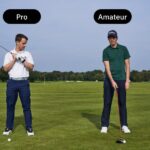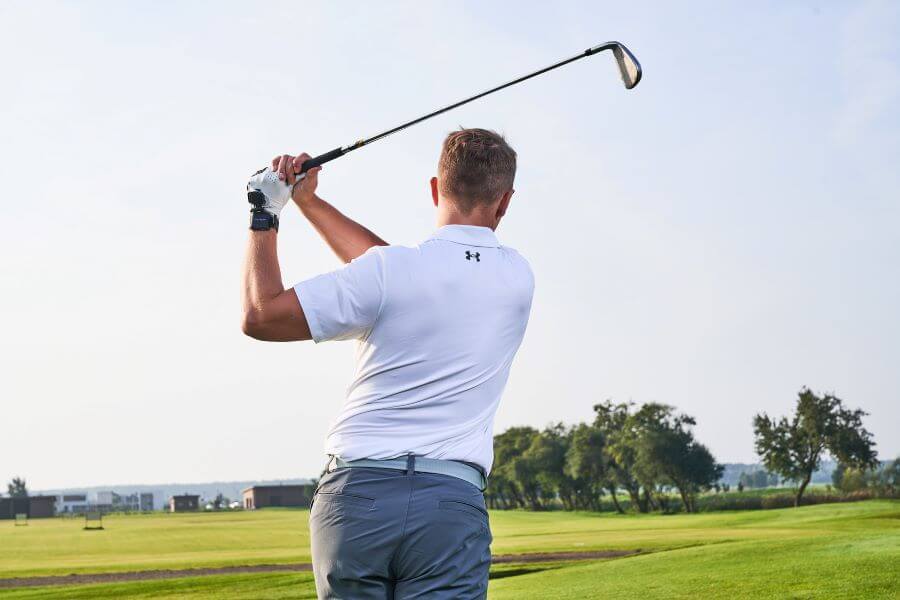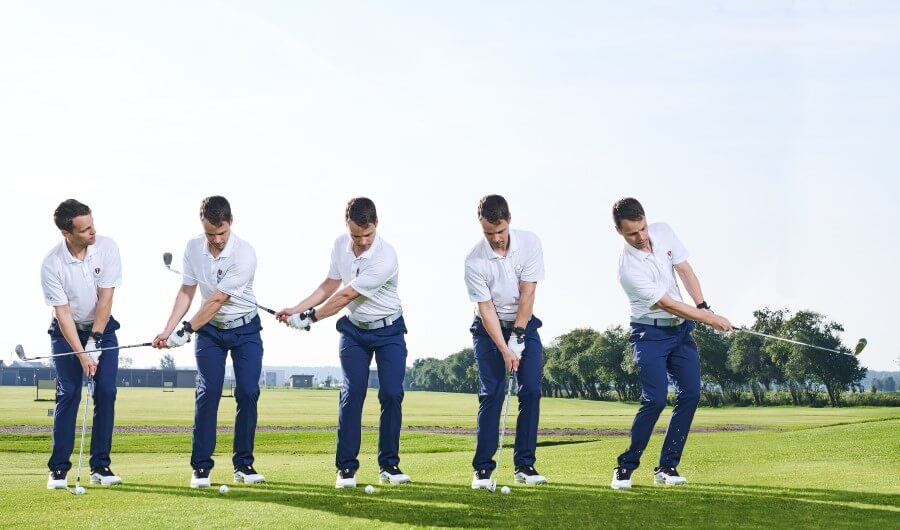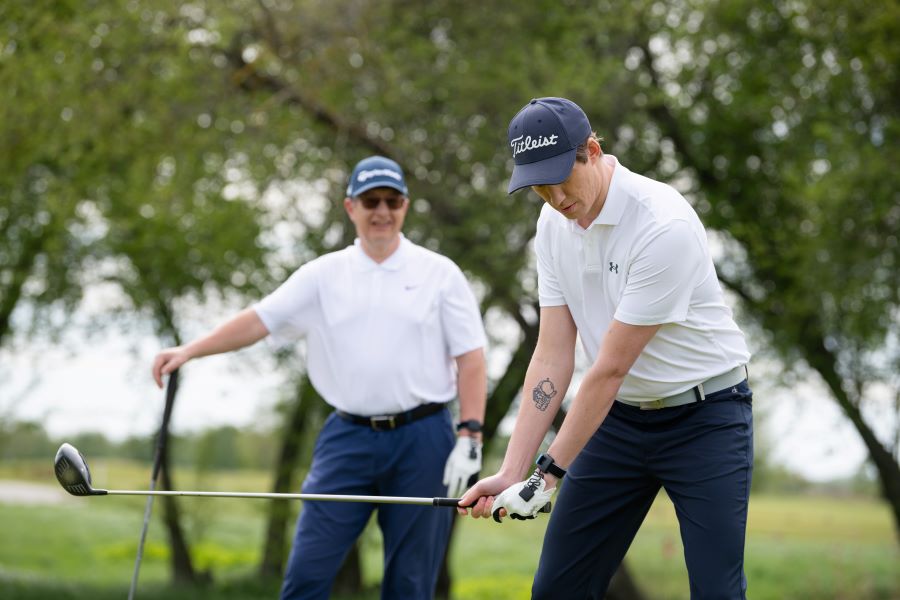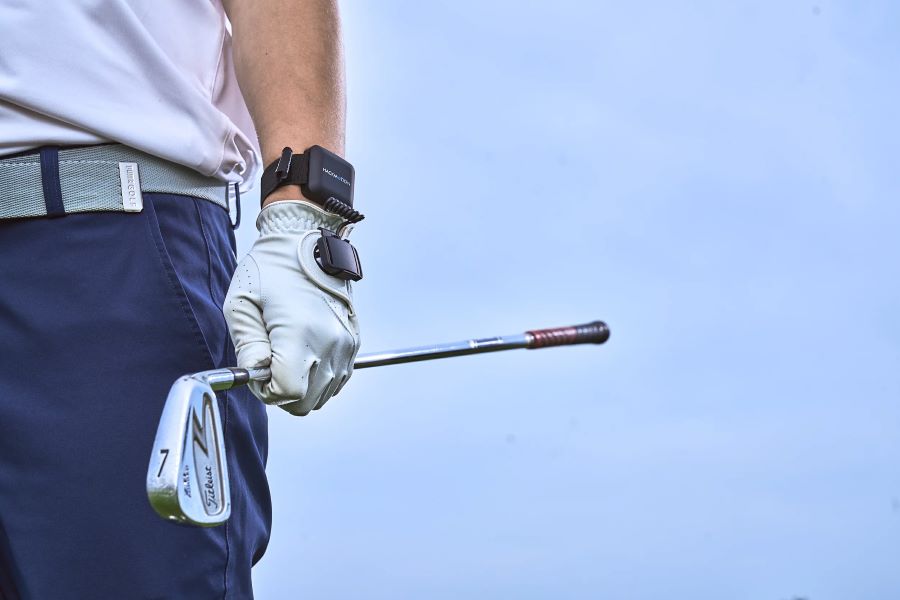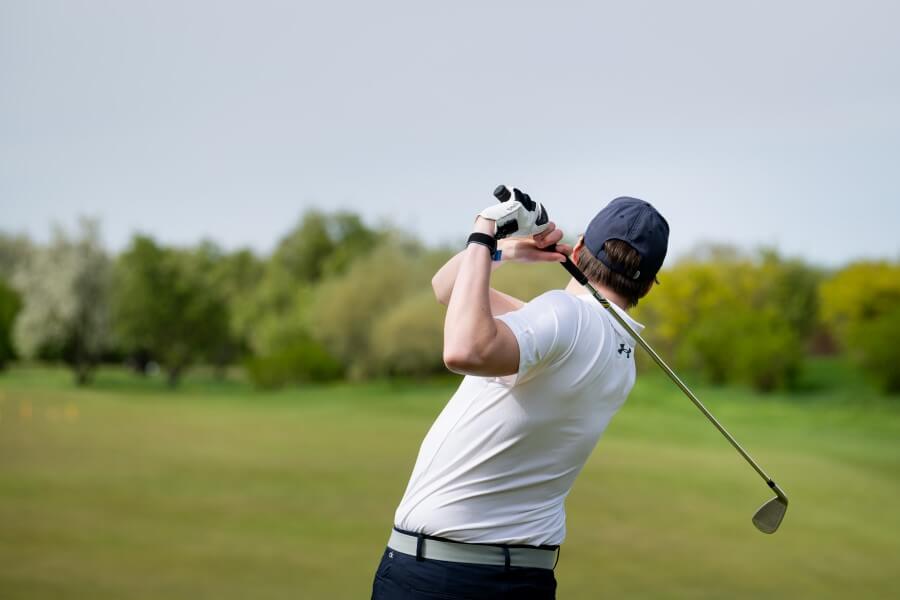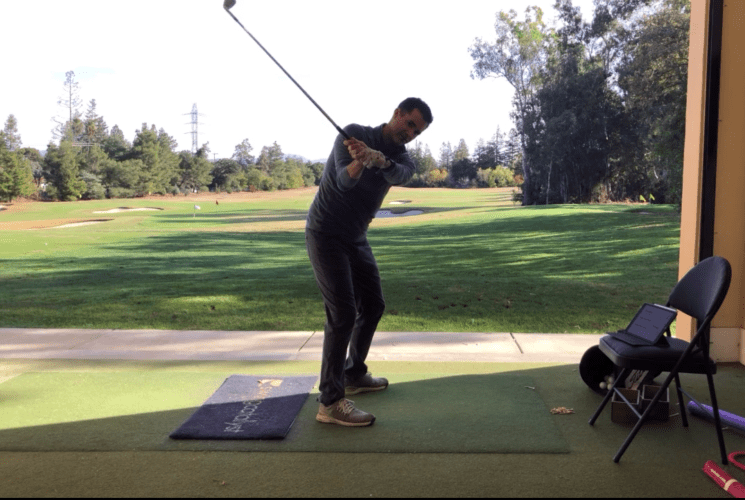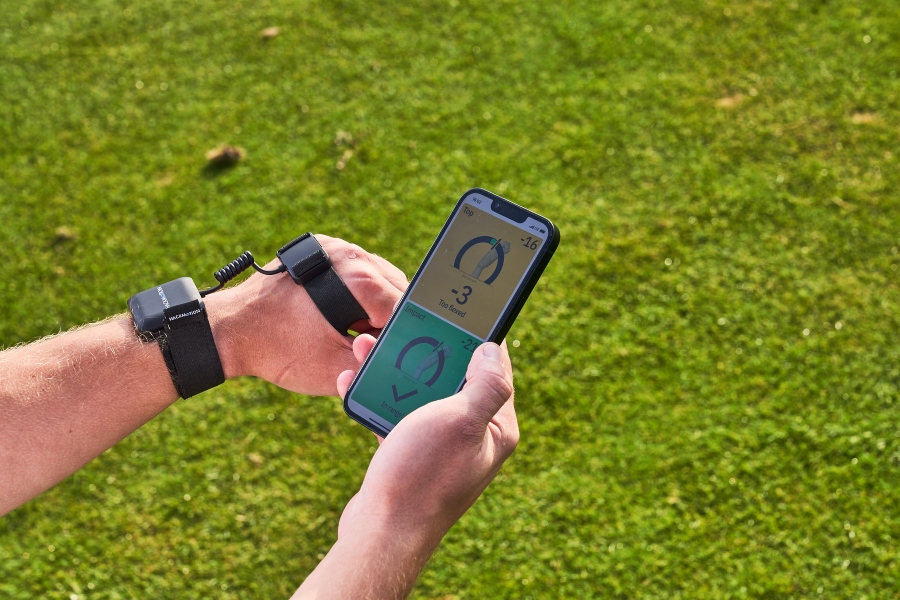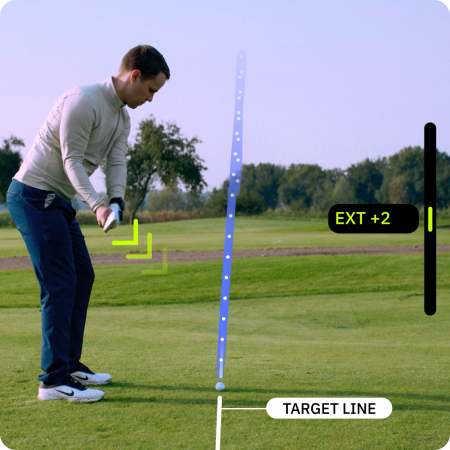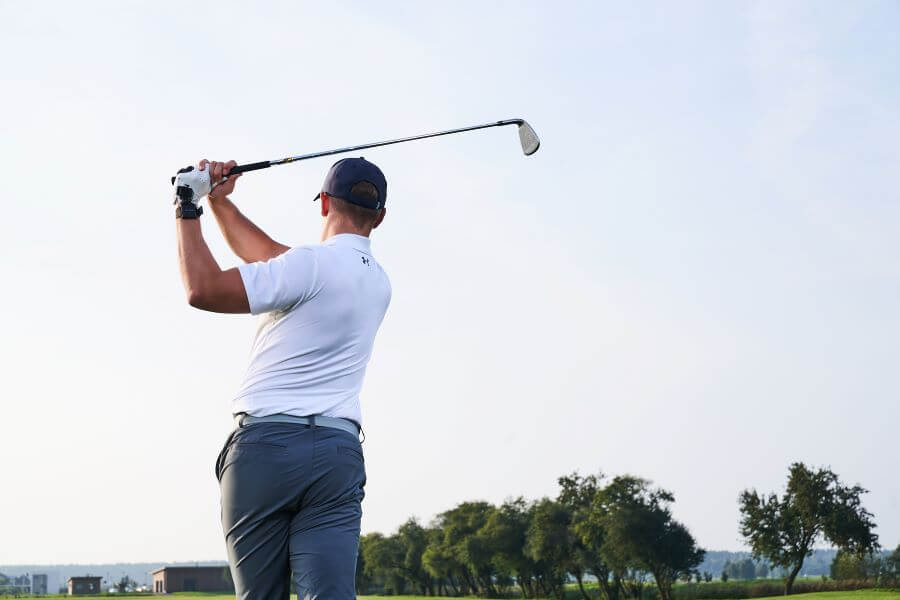The Role of Wrist Action in Golf Swing: A Must-Read Guide for Golfers
Could you analyze a golf swing and tell whether or not the wrist action was correct?
If you answered no, you are not alone.
In fact, many professionals are not even entirely sure about how their wrists should be positioned and how angles will impact their ball flight.
I get it; wrist action in the golf swing is confusing.
However, with the right tools, the correct knowledge, and a bit of time working out the details, you can improve the way you swing a golf club and become a more consistent player.
Ever heard the term, “It’s all in the wrists”? Whether that was referring to golf or not remains to be seen, but if you want to improve your wrist action, you are in the right place.
Wrist Action in Golf Swing (Key Takeaways)
After analyzing more than 1,000,000 golf swings, we’ve poured a lot of detail and discovery into the information here.
However, if you’re short on time, here are a few of the most essential facts to take with you right now:
- The wrists move in three ways: extension/flexion, radial deviation/ulnar deviation, and pronation/supination.
- Flexion and extension in the wrists are most critical for learning to control the clubface and hit straighter shots.
- The wrist position changes throughout the swing, so it must be correct at setup and at the top of the backswing to have the best chance for a square and solid impact.
- The best way to measure and analyze wrist action in golf is to use the HackMotion wrist sensor and record data at setup, top of the backswing, and impact.
- A quick way to fix slices, hooks, pushes and pulls is to get the proper wrist action in your golf game.
If you prefer to watch instead of read, here’s a recap of all the basics of wrist action. This video will help you understand the role of the wrists and how wrist action impacts your golf game.
Contents
- What Should the Wrists Do in The Golf Swing?
- Wrist Positions in Golf (How do the Wrists Move)
- How do the Wrists Work Throughout the Golf Swing?
- Lead Wrist vs Trail Wrist Position in the Golf Swing
- How to Troubleshoot Bad Wrist Action in the Golf Swing?
- How do You Measure Wrist Movement?
- How do I Know if My Wrist Angle is Correct?
- Can Improving Wrist Angles Make You a Better Golfer?
- Drills to Improve Wrist Movement in Golf Swing
- Final Thoughts
What Should the Wrists Do in The Golf Swing?
Before we dive into the role of wrist action in the golf swing fully, let’s start with a basic understanding of what the wrists do in the golf swing.
Your wrists control the clubface.
Why does that matter?
The angle of the clubface controls where the golf ball goes!
That should motivate you to stick around and fully understand how you can improve your wrist action in your golf game.
Wrist Positions in Golf (How do the Wrists Move)
Wrist action in golf is best understood when you know how the wrist can move.

Extension/Flexion
Extension and flexion are more commonly referred to as bowing and cupping or arching and bending the wrist.
This is the wrist action that will open and close the clubface. Extension will open the face of your golf club; flexion will close it.
As you swing the golf club, if you can control the extension and flexion in your wrist, you will have more control over the direction of your golf shot.
Common Issues Seen in Golf
- An open clubface at impact caused by too much wrist extension in the lead wrist.
- Flipping at impact because of a poor position at the top of the backswing.
- Adding too much extension to the lead wrist during the backswing from the setup to the top.

More extension (cupping) opens the clubface and delays squaring it to the target. More flexion (bowing) closes the clubface earlier and helps to square it to the target.
Radial Deviation/Ulnar Deviation
It’s easiest to think about radial and ulnar deviation as cocking or uncocking of the wrist.
The movement here is more side to side. When you cock your wrist, the thumb gets closer to your forearm; when you uncock, the pinky finger moves closer to your forearm.
Radial deviation increases the wrist cock, whereas ulnar deviation decreases it. This is where the power comes from.
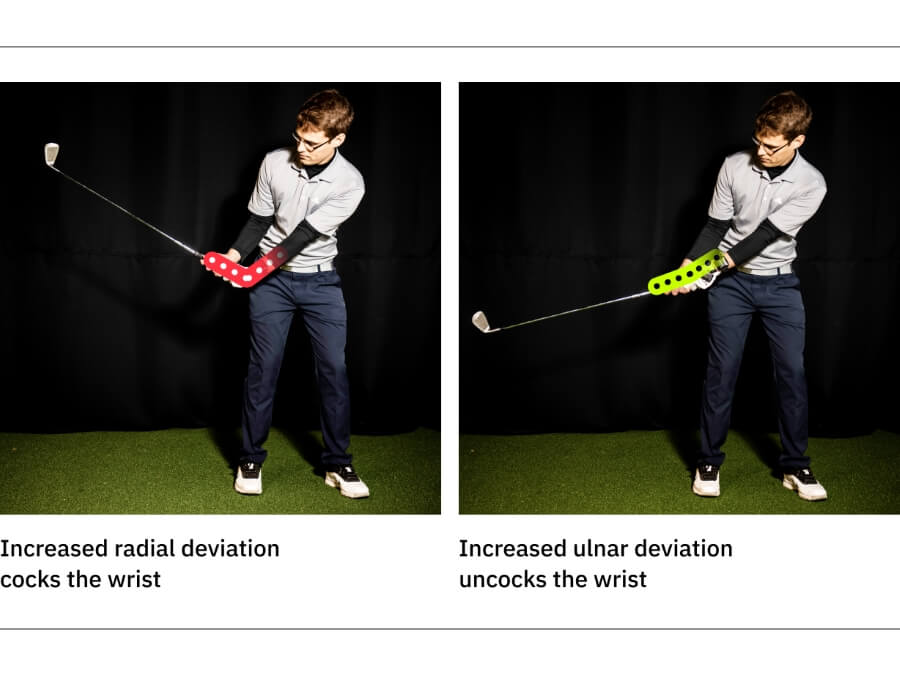
Common Issues Seen in Golfers
- Increasing radial deviation too much and extended the wrist.
- Early wrist hinge opening the clubface making it difficult to recover.
Rotation (Pronation/Supination)
The third of the key wrist movements in the game of golf is wrist rotation.
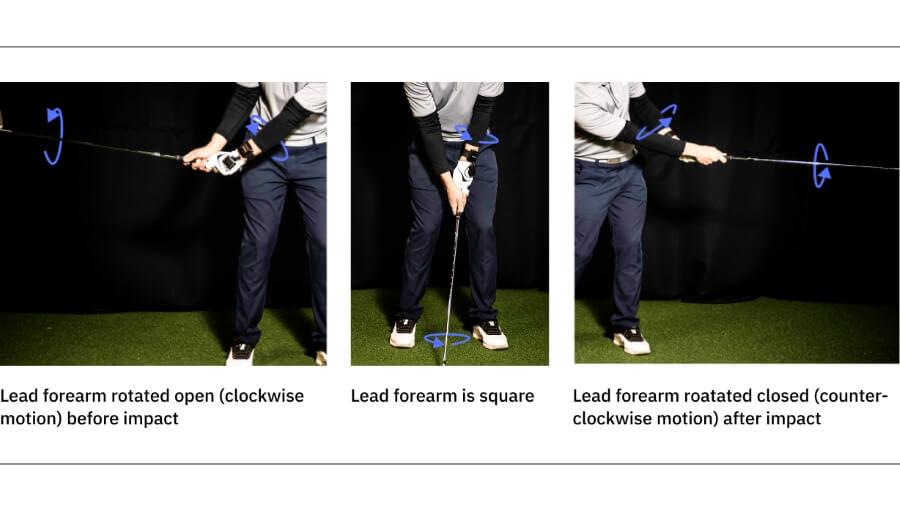
Pronation and supination mean more of a turning of the entire wrist.
In fact, the rotation almost feels more in the forearm than in the wrists.
Take your hand and hold it out before you so that your thumb points up to the sky. Now, turn your hand so that your thumb is facing the ground; that is wrist rotation. With this movement, you will feel more like your entire forearm rotates, not just the wrist.
Common Issues Seen in Golfers
- Lack of proper rotation through impact leaving the clubface open
- Too much rotation right before impact causing the shot to pull
How do the Wrists Work Throughout the Golf Swing?
Wrist action in golf will change as you move from setup to backswing to impact. Understanding these motions will make it a little easier for you to repeat them.
Setup
The grip is one of the most important things to focus on at setup.
If the hands are not on the club properly from the start, the chance of getting your wrists into the right position throughout the swing is significantly reduced.
Keep the club in the fingers of your hand.
If the club is too much in the palms, wrist action is challenging to feel and keeps you from getting the wrist angles that could generate the most power.
Backswing
The tricky part about the top of the backswing is that more than one position can work.
Obviously, a neutral lead wrist position will give you the easiest route back to the ball, but many great players are flexed with their wrists at the top.
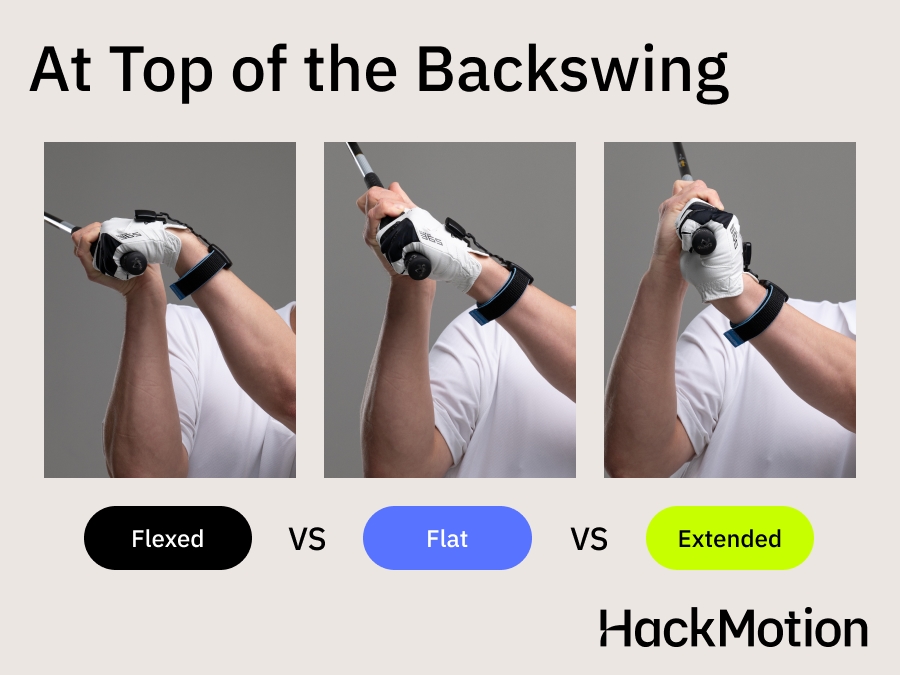
With backswing positions in the golf swing, you will notice more of a range of what is acceptable instead of one specific number or angle you should be attempting to reach.
Great ball strikers have consistency in their swing, and to do this, the extension, radial deviation, and rotation in the backswing are done the same way each time.
Downswing and Impact with the Ball
The downswing and the area just behind the ball before impact are where most amateur golfers need help with their wrist position.
With the proper wrist mechanics in the downswing and at impact, you will see a better swing path, more consistent strike, higher clubhead speeds, and the desired ball flight that you are looking for.
To get to impact with a square or closed clubface, you need to get your lead wrist to a flexed position before you get to the ball.
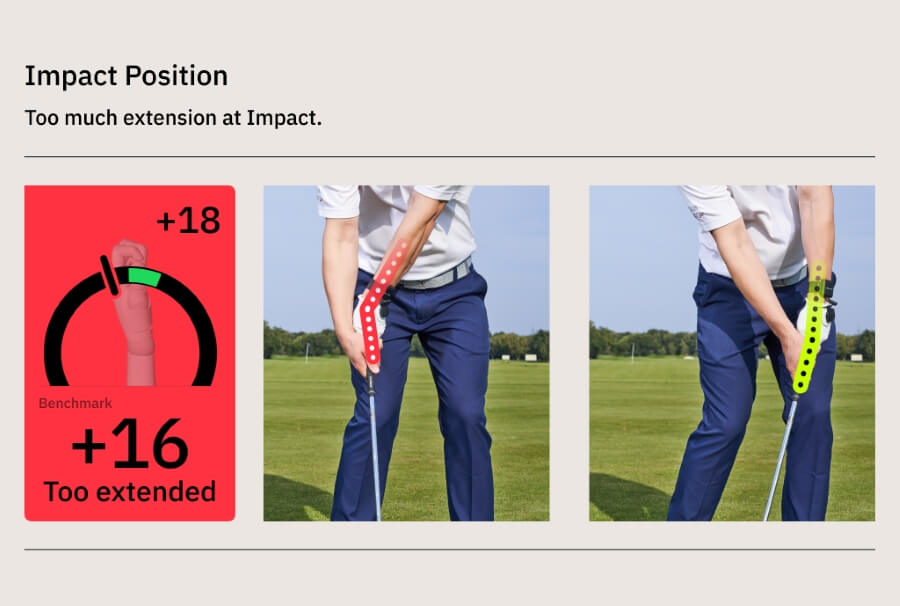
Here are a couple of key things to keep in mind here:
- Experiment with more flexion in your lead wrist and see if it helps you hit more consistent shots.
- More radial deviation through impact is best for golfers looking to increase club head speed.
- Additional wrist supination will lead to a more out-to-in path; the opposite would create an in-to-out swing path.
The golf swing has too many moving parts for us to find an exact number for flexion/extension or rotation through the ball.
Instead, maintaining consistency and learning what that square clubface feels like will get your game to the next level.
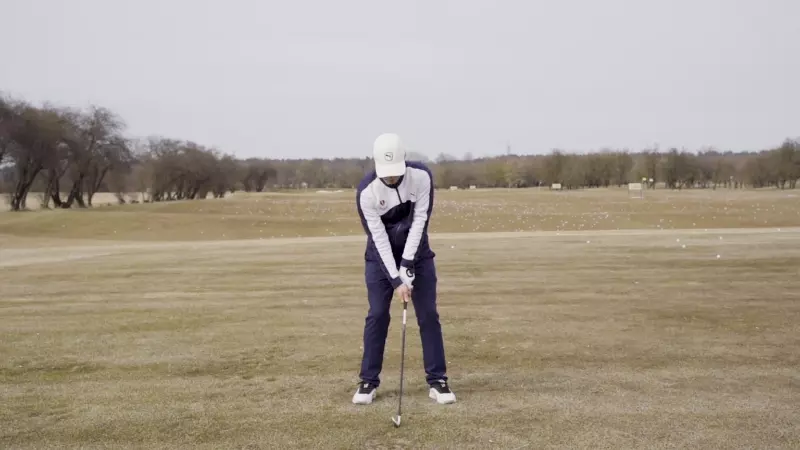
Lead Wrist vs Trail Wrist Position in the Golf Swing
The trail wrist position in golf is essential; however, this experiment quickly reveals why the lead wrist is most frequently discussed.
Take a golf club and swing to the top of your swing, focusing on maintaining the extension in your lead wrist. Now, swing and focus on keeping the same wrist position in the non-lead wrist.
It’s tough to feel and doesn’t impact the clubface in the same way that the lead wrist does.
This is why the HackMotion wrist sensor is worn on the left wrist for the right handed player.
How to Troubleshoot Bad Wrist Action in the Golf Swing?
The best way to troubleshoot bad wrist action in the golf swing is to look at your struggle and then decide if you have an extension/flexion, radial/ulnar deviation, or rotation problem.
Once you have that narrowed down, using HackMotion and drills will help you figure things out.
Slices and Hooks (From Slightly to Severely Offline)
Issues with flexion and extension cause most slices and hooks.
Most amateur golfers increase extension in their backswing and therefore can’t get the club to square or a point of flexion on the downswing. As they get closer to the ball, there is insufficient flexion to close the clubface.
Start focusing on maintaining the proper extension to the top of your swing and, from there, flexing the wrist through impact.
One of the best drills to accomplish this is the motorcycle drill. You will feel your hands on the grip in the same way you feel them on a motorcycle handle.
Pulling and Pushing Shots
A pull or a push can be a lot easier to fix than a hook or a slice when you have the right drills.
Many golfers who struggle with pulling or pushing their golf shots have trouble with forearm rotation.
The handshake drill used by Athletic Motion Golf gives you a much better understanding of what it takes to ensure your golf shot does not end up left or right of the target.
The proper rotation has you rotate your lead arm back as if you were shaking hands with someone standing to the right of you. Then, you rotate your arm through impact so you can shake hands with someone standing on the left of you.
Loss of Power and Proper Golf Ball Compression
If you are losing power and compression take a look at the models of the professionals that HackMotion has collected in recent years. The most powerful discovery is that professional golfers do an excellent job of maintaining wrist extension on the backswing.
The amount of extension at the start is not as important as it is to maintain that throughout the swing.
From the top of the swing and towards the ball, professional golfers move from extension to the point of flexion in their wrists to close the clubface. In the example of this professional golfer, a starting wrist extension of around 25 almost wholly disappears at impact so that the wrist is flat.
This video from Rob Cheney will help you work out the proper wrist action for a variety of shots.
Inconsistent Impact Position
This video from Craig Hansen gives you some practical drills to learn the proper impact position in golf.
The impact will change slightly depending on what club you have in your hand, but there are some basics that all professionals and amateurs need to have in place.
How do You Measure Wrist Movement?
Before the release of the HackMotion wrist sensor, measuring wrist movement was very difficult.
What wrist angle looks like and how it feels can be different. That’s where HackMotion comes into play.
With the HackMotion wrist sensor, you can hit golf balls as usual and have your wrist angles and positions measured throughout the swing.
The most valuable information here is the ability to see if your wrist motion compares to that of the best ball strikers in the game. In addition, you can track your progress from one practice session to the next.
You’ll also use audio feedback to give you real-time information about where your wrist is during the swing.
How do I Know if My Wrist Angle is Correct?
As we know, there is no perfect wrist angle; the game of golf just doesn’t work like that.
For golfers who practice hard and study the game, not having a perfect number to strive for is a bit frustrating, which is understandable.
Luckily, you can use benchmarks to help get you to the correct range.
Alistair Davies looks at flexion and extension of the lead wrist and has created some key benchmarks to help you understand when you are on the right track.
Here are his measurements with HackMotion at the key positions:
- Address: The lead wrist has a +20 degrees extension (cupping).
- Takeaway: Extension of the wrist is stable and remains at +20 degrees. During this stage, the radial deviation is added.
- At the top: Flattening of the lead wrist should happen. Extension should not be higher than in address; consider 0-20 degrees of extension.
- In transition: The lead wrist should go into flexion (bowing) at the beginning of the downswing. Alistair’s wrist flexion ranges from -6 to -12 degrees. Maintain a flexed position throughout the downswing.
- At impact: His lead wrist remains flexed. The range is similar to the one in transition: -6 to -12 degrees.
- After impact: The lead wrist goes into extension.
Can Improving Wrist Angles Make You a Better Golfer?
Many amateur golfers shy away from learning about wrist angles in golf simply because the topic is so complicated.
Improving wrist angle in the golf swing can help you return the clubface of your golf clubs to square each time you swing.
When your clubface is square, and you have control over it, expect:
- Straighter shots.
- More distance.
- Easier workability.
- Less dispersion.
- Better compression and spin.
- Lower scores.
Drills to Improve Wrist Movement in Golf Swing
In addition to the drills shown above in our troubleshooting section, you can also do these drills to help improve your wrist action.
Split Hands Impact Drill
Sometimes, giving the hands a little separation in the swing can help you feel what it takes to get the clubface square at impact.
Here is a drill that should help you finally feel that proper extension on both the backswing and downswing.
Better Pitch Shot Drill
Golfers often struggle with the proper wrist action when pitching and chipping. The angles can change quite a bit depending on the ball flight you are looking for.
If you have been trying to keep the “clubface looking at the ball,” you may want to watch this video from Athletic Motion Golf.
The information can help you feel that natural rotation of your arms and hands back away from the golf ball.
HackMotion Training
Working with the HackMotion wrist sensor will give you all the insight into what is working and what is not working when it comes to wrist motion.
While wearing HackMotion, collect data on where your wrist angles are and how they compare to those of professionals. Use the data in the HackMotion app to practice and work on your wrist action.
There are training challenges and drills you can use that are specific to the moves you are making with your wrists in your game.
Final Thoughts
There is a lot of information here about the proper wrist action in the golf swing.
When you look at concepts in golf, wrist action is, without a doubt, one of the most complex.
Now that you understand better, it’s time to get out there with your HackMotion and see what kind of progress you can make.




